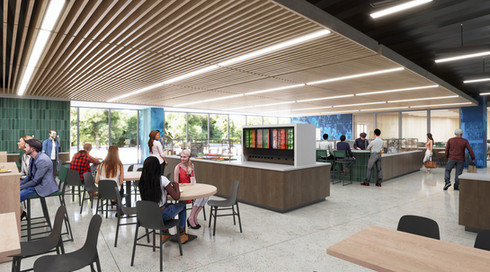Crafting Culinary Communities: Emerging Trends in College and University Foodservice Design
- Marcy Weiss

- Apr 25, 2024
- 4 min read

Last week, we had opportunity to present at the NACAS South Regional CSX. Were you there? If you were and you missed our panel on Sunday because you attended another session, or you didn’t make it to Orlando at all … that’s ok. There was a lot of great content shared, including some of the college and university foodservice design trends, and I didn’t want you to miss out, so I’m including just a few of the key points from our session right here!
In the realm of higher education, foodservice design is undergoing a fascinating evolution. Gone are the days of uninspiring cafeteria layouts and lackluster dining experiences. Today, colleges and universities are reimagining their culinary spaces as vibrant hubs of activity, fostering community, wellness, and innovation. Let's delve into some of the emerging trends shaping the design of campus dining environments.
Multifunctional Spaces
Modern campus dining facilities are embracing the concept of multifunctionality. Gone are the rigid delineations between dining halls, cafes, and study areas. Instead, flexible layouts are being adopted to accommodate a variety of activities, from collaborative study sessions to social gatherings and culinary events. By blurring the lines between dining and social spaces, universities are creating dynamic environments that cater to the diverse needs of students and faculty alike.
The images below illustrate this idea. The photos are from a completed project at the University of Maine's Beaver Lodge and the rendering features a University of Houston collaboration hub and study area that's alongside a traditional resident dining hall.
Sustainable Design
As sustainability takes center stage in global conversations, colleges and universities are incorporating eco-friendly principles into their foodservice design strategies. This includes utilizing energy-efficient equipment, implementing waste reduction initiatives, and sourcing locally sourced, seasonal ingredients. Additionally, some institutions are exploring innovative solutions such as composting programs and edible gardens, further reinforcing their commitment to environmental stewardship.


The team at elite|studio e has had the opportunity to be at the forefront of this effort, partnering with the foodservice operator and Stony Brook University to make it one of the first college campuses to have a Freight Farm indoor agricultural system on campus.
On-Demand and Mobile Ordering
In an era defined by convenience and digital innovation, on-demand and mobile ordering platforms are revolutionizing the way students access campus dining options. Whether through dedicated mobile apps or self-service kiosks, universities are empowering students to pre-order meals, customize their dining experiences, and skip the lines during peak hours. This not only enhances convenience but also minimizes wait times and promotes efficient use of resources. Similarly, we’ve had the opportunity to work with several universities to bring just-walk-out technology to their campuses (see rendering on bottom right). The rendering on the top right illustrates a hot and cold mobile pick-up shelving outside of the university dining hall.
Wellness-Centric Design Recognizing the integral connection between nutrition and overall well-being, many colleges and universities are prioritizing wellness-centric design principles in their foodservice facilities. This includes the incorporation of open kitchen concepts, where students can observe their meal being crafted and engage with culinary staff. Additionally, mindful eating spaces, designated relaxation areas, and access to nutritional resources further support students' holistic health goals
For example, elite | studio e helped this southern-based university envision incorporating Servue, a touchless dispensing food bar, into it’s college dining experience to provide a fresh salad offering (lower left image). Our team has also partnered with operators on designing and building stations that allow students to prepare their own meals (lower right image).
Cultural Diversity and Inclusivity
With increasingly diverse student populations, campus dining design is embracing cultural inclusivity as a guiding principle. From the incorporation of diverse cuisines and international food stations to the celebration of cultural holidays and traditions, universities are creating dining environments that reflect the rich tapestry of their communities. This fosters a sense of belonging and appreciation for cultural diversity among students and staff alike.
It can be difficult to determine which cuisines to include, so let's get flexible! Stations with hot and cold pans, swappable counter top equipment and digital signage all allow for a rotating, multi-cultural offering.
Collaborative Partnerships

In an effort to enhance the culinary experience and promote local engagement, colleges and universities are forging collaborative partnerships with local chefs, food vendors, and producers. These partnerships not only bring fresh perspectives and culinary expertise to campus dining but also support the local economy and foster a sense of community between the university and its surrounding neighborhoods. In some instances, elite |studio e has designed rotating flexible stations allowing the cuisine to rotate, and in others we’ve incorporated brick and mortar locations, or a full-time dining hall station. For example, several Massachusetts college campuses feature Sal’s Pizza, a local staple, in their dining hall, including Wentworth Institute of Technology's Beatty Hall.
In the ever-evolving world of higher education, colleges and universities are really stepping up their game when it comes to dining experiences on campus. Where we eat and hang out matters (think about how far in advance we make reservations sometimes for the vibe and menu offering). So, campuses are getting a serious makeover to be more welcoming, sustainable, and just downright cool … transforming them into hubs of activity and connection. We’re excited to partner with operators, universities and colleges, architects, and other project stakeholders to create spaces where students can chow down, make friends, and explore new flavors—all while nourishing their minds and bodies.
















Comments